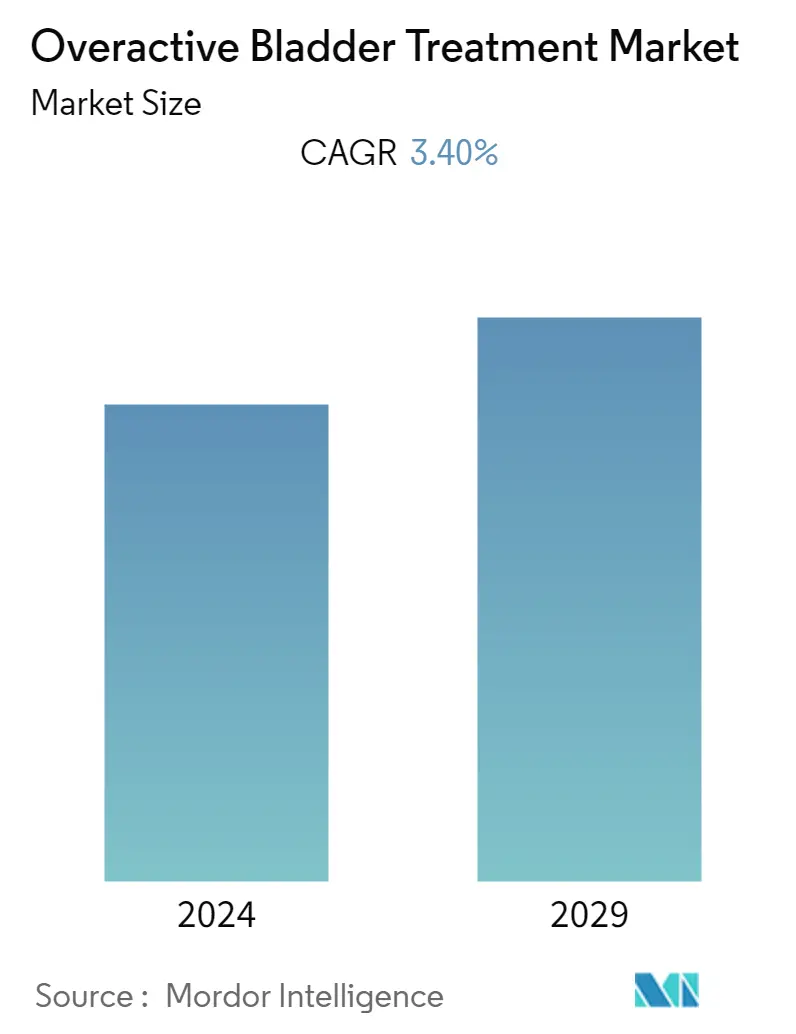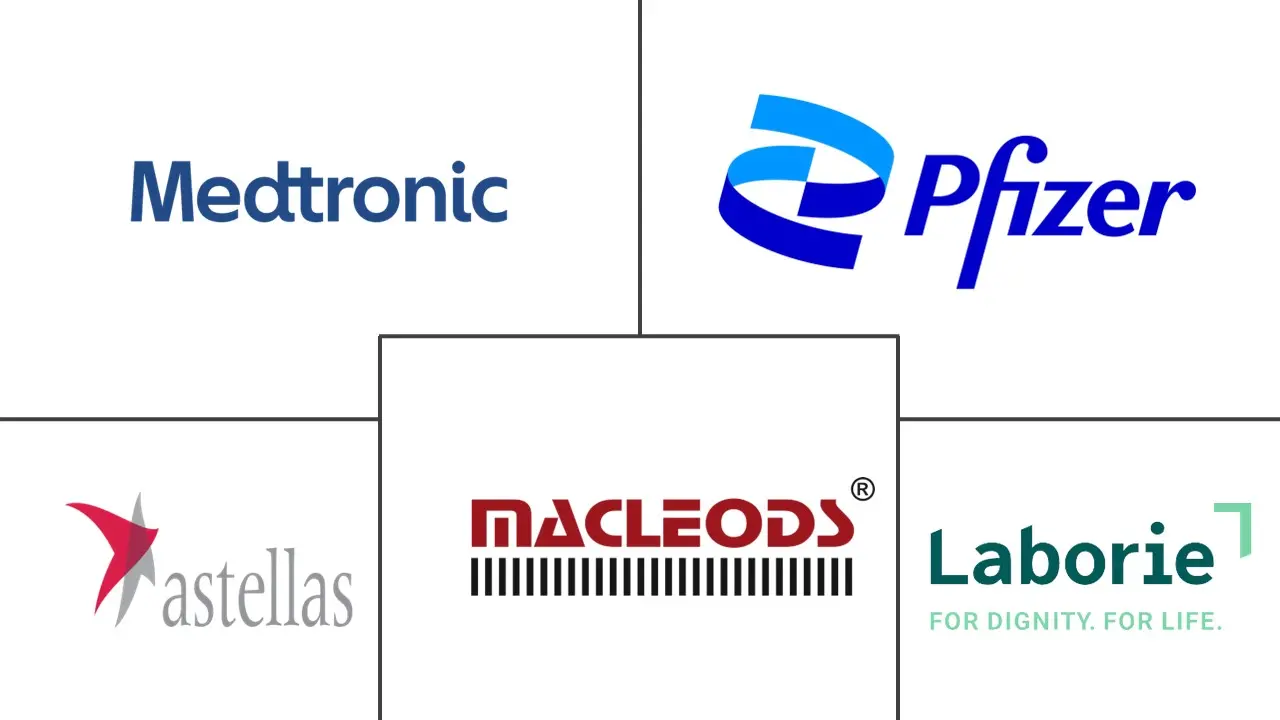Market Size of Overactive Bladder Treatment Industry

| Study Period | 2019 - 2029 |
| Base Year For Estimation | 2023 |
| CAGR | 3.40 % |
| Fastest Growing Market | Asia Pacific |
| Largest Market | North America |
| Market Concentration | Medium |
Major Players
*Disclaimer: Major Players sorted in no particular order |
Overactive Bladder Treatment (OAB) Market Analysis
The overactive bladder (OAB) treatment market is expected to register a CAGR of 3.4% over the forecast period.
COVID-19 pandemic significantly impacted the overactive bladder treatment market growth due to the high risk of overactive bladder symptoms in the COVID-19 recovered patients. For instance, as per the study published by Springer Journal in November 2021, patients were reported with worsening overactive bladder symptoms 10-14 weeks after hospitalisation with COVID-19. Similarly, according to an article published by the Elsevier Journal in October 2022, individuals with positive COVID-19 cases were at higher risk of worsening overactive bladder (OAB) symptoms. Therefore, the COVID-19 infection rate associated with overactive bladder symptoms increased the demand for overactive bladder treatments amid the pandemic. However, with the reduction of COVID-19 cases, the need for OAB drugs for COVID-19 patients is expected to show stable growth during the forecast period.
The primary factor driving the market growth include the rising prevalence of various diseases that causes overactive bladder, such as urinary tract infections (UTI), diabetes, bladder cancer, and neurological disorders like Parkinson's disease and stroke. UTIs occur when bacteria enter the urinary tract and cause infection. In addition to pain and burning during urination, UTIs lead to overactive bladder symptoms, including frequent urination and urgency. For instance, according to an article published by the StatPearls Journal in November 2022, approximately 40% of women in the United States are estimated to develop a urinary UTI once in their lifetime. Therefore, the high prevalence of UTI will drive the demand for OAB treatment drugs during the forecast period. In addition, diabetes, particularly uncontrolled diabetes, can affect the nerves that control the bladder, leading to overactive symptoms. High blood sugar levels can damage the nerves over time, causing issues with bladder control. Hence, the increasing prevalence of diabetes may also lead to an increase in the OAB burden. For instance, according to the December 2021 report of the IDF Diabetes Atlas, approximately 537 million adults were living with diabetes worldwide in 2021, and the number was projected to increase to 643 million by 2030 and 783 million by 2045. Thus, owing to the high prevalence of risk factors, the burden of OAB is expected to increase, thereby driving the demand for OAB therapeutics.
Moreover, the increasing number of ongoing clinical trials and novel drug approvals is also projected to augment market growth. The surge in clinical trials is projected to drive market growth by introducing novel OAB treatment drugs. For instance, in May 2022, Urovant Sciences presented data from the Phase 3 EMPOWUR Extension Study of GEMTESA(vibegron) 75 mg overactive bladder treatment drug therapy. It will further confirm this drug's potential utility and durability in this patient population and examine the long-term effects of the product. The drug showed sustained reductions in average daily micturition, urge urinary incontinence (UUI) episodes and urgency episodes. Hence, as more drugs complete clinical trials and receive regulatory approvals, the market will witness a surge in innovative therapies, enhancing patient outcomes and fostering market growth.
Thus, owing to the rising prevalence of various disorders like UTI and diabetes and the surging number of ongoing clinical trials of OAB treatment drugs, the market is expected to project growth over the forecast period. However, alternative treatment options such as physical therapies and surgeries may impede the market growth during the study period.
Overactive Bladder Treatment (OAB) Industry Segmentation
As per the scope of the report, an overactive bladder, also known as OAB, causes a frequent and sudden urge to urinate that may be difficult to control. Overactive bladder treatments are used to treat the sudden involuntary contraction of the muscle in the urinary bladder wall, leading to urinary urgency, frequency, nocturia, and urge incontinence. The Overactive Bladder Treatment Market is Segmented by Therapy (AntiCholinergics, Mirabegron, Neurostimulation, Intravesical Instillation, and Other Therapies), Disease Type (Idiopathic Overactive Bladder and Neurogenic Overactive Bladder), and Geography (North America, Europe, Asia-Pacific, Middle East and Africa, and South America). The report also covers the estimated market sizes and trends for 17 countries across major regions globally. The report offers the value (in USD million) for the abovementioned segments.
| By Therapy | |
| Anticholinergics | |
| Mirabegron | |
| Neurostimulation | |
| Intravesical Instillation | |
| Other Therapies |
| By Disease Type | |
| Idiopathic Overactive Bladder | |
| Neurogenic Overactive Bladder |
| Geography | ||||||||
| ||||||||
| ||||||||
| ||||||||
| ||||||||
|
Overactive Bladder Treatment Market Size Summary
The overactive bladder (OAB) treatment market is poised for growth, driven by the increasing prevalence of conditions such as urinary tract infections, diabetes, and neurological disorders that contribute to OAB symptoms. The market experienced a notable impact from the COVID-19 pandemic, as recovered patients exhibited worsening OAB symptoms, thereby boosting demand for treatments. As the pandemic's influence wanes, the market is expected to stabilize, supported by ongoing clinical trials and the introduction of novel drugs. The rise in diabetes and other risk factors is anticipated to further elevate the demand for OAB therapeutics, as these conditions can exacerbate bladder control issues. Additionally, the market is witnessing a surge in innovative therapies, with more drugs completing clinical trials and receiving regulatory approvals, which is expected to enhance patient outcomes and drive market expansion.
Neurostimulation therapies are gaining traction as a preferred treatment option for patients unresponsive to traditional pharmacologic therapies, such as anticholinergics and mirabegron. This minimally invasive approach offers a safer alternative to more invasive procedures, attracting a growing patient base and contributing to market growth. The North American region is expected to hold a significant share of the market, fueled by a high prevalence of OAB and a rising number of product launches. Strategic partnerships and educational campaigns are further propelling regional market growth, offering lucrative opportunities. The competitive landscape is characterized by the presence of key players, with ongoing product launches and regulatory approvals enhancing the market's dynamism.
Overactive Bladder Treatment Market Size - Table of Contents
-
1. MARKET DYNAMICS
-
1.1 Market Overview
-
1.2 Market Drivers
-
1.2.1 Increasing Prevalence of Overactive Bladder and its Risk Factors
-
1.2.2 Increasing Research Investments and Novel Drug Launches
-
-
1.3 Market Restraints
-
1.3.1 Presence of Alternative Treatment Options such as Physical Therapies and Surgeries
-
-
1.4 Porter's Five Forces Analysis
-
1.4.1 Threat of New Entrants
-
1.4.2 Bargaining Power of Buyers/Consumers
-
1.4.3 Bargaining Power of Suppliers
-
1.4.4 Threat of Substitute Products
-
1.4.5 Intensity of Competitive Rivalry
-
-
-
2. MARKET SEGMENTATION (Market Size by Value - in USD million)
-
2.1 By Therapy
-
2.1.1 Anticholinergics
-
2.1.2 Mirabegron
-
2.1.3 Neurostimulation
-
2.1.4 Intravesical Instillation
-
2.1.5 Other Therapies
-
-
2.2 By Disease Type
-
2.2.1 Idiopathic Overactive Bladder
-
2.2.2 Neurogenic Overactive Bladder
-
-
2.3 Geography
-
2.3.1 North America
-
2.3.1.1 United States
-
2.3.1.2 Canada
-
2.3.1.3 Mexico
-
-
2.3.2 Europe
-
2.3.2.1 Germany
-
2.3.2.2 United Kingdom
-
2.3.2.3 France
-
2.3.2.4 Italy
-
2.3.2.5 Spain
-
2.3.2.6 Rest of Europe
-
-
2.3.3 Asia-Pacific
-
2.3.3.1 China
-
2.3.3.2 Japan
-
2.3.3.3 India
-
2.3.3.4 Australia
-
2.3.3.5 South Korea
-
2.3.3.6 Rest of Asia-Pacific
-
-
2.3.4 Middle East and Africa
-
2.3.4.1 GCC
-
2.3.4.2 South Africa
-
2.3.4.3 Rest of Middle East and Africa
-
-
2.3.5 South America
-
2.3.5.1 Brazil
-
2.3.5.2 Argentina
-
2.3.5.3 Rest of South America
-
-
-
Overactive Bladder Treatment Market Size FAQs
What is the current Overactive Bladder Treatment Market size?
The Overactive Bladder Treatment Market is projected to register a CAGR of 3.40% during the forecast period (2024-2029)
Who are the key players in Overactive Bladder Treatment Market?
Medtronic PLC, Astellas Pharma, Inc., Macleods Pharmaceuticals Ltd, Pfizer, Inc and AbbVie Ltd. are the major companies operating in the Overactive Bladder Treatment Market.

